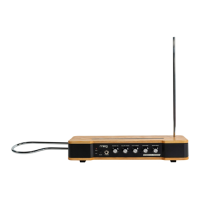27
CALIBRATION POINTS
Your Moog Etherwave
Theremin is calibrated
and ready to play when
it arrives from the Moog
Music factory. These
calibration parameters
are controlled by internal
trimpots, or trimmers.
Access points on the
front, top and rear panels
allow these trimmers
to be adjusted, if the
need arises.
WARNING: Do not attempt to adjust the internal trimpots without first reading and comprehending the
information and directions given in the following section. It is possible to render the instrument unplayable by
adjusting these circuits without following the instructions. Trimpots or variable inductors damaged by improper
tuning are not covered by warranty. Please contact Moog Tech Support with questions regarding calibration.
TOP PANEL
Etherwave Theremin contains three analog oscillators. One is used for generating a Volume Control
signal, and the other two—the Fixed Pitch Oscillator (FPO) and the Variable Pitch Oscillator (VPO)—are
used to generate the audible tone you hear through a process known as heterodyning. All of these
oscillators are tuned to frequencies well above the range of human hearing. The Volume Oscillator
is typically around 515 kHz, and the Pitch Oscillators are typically about 330 kHz.
All of these oscillators are calibrated at the Moog Music factory and there is little need to adjust
them; however, for the advanced thereminist, we have included access holes for adjusting the
variable inductors for calibrating the instrument’s oscillators. To access the three top panel calibration
points, remove the plastic insert by simply pulling it up from its edges.
Do not attempt calibration unless you understand the procedure, and once calibrated, do not
readjust unless necessary. Please note that the variable inductors are adjusted by turning the cores
with the slotted side of the non-conductive adjustment tool provided with your Etherwave Theremin.
These variable inductors can be damaged by advancing the internal mechanism too far clockwise or
counterclockwise; only small adjustments are ever required.
VOLUME OSCILLATOR TUNING
The access hole closest to the Volume Antenna allows control of the tunable core of the variable
inductor used to set the frequency of the volume oscillator. The frequency of the volume oscillator
determines the slope, or the rate at which the volume response changes as the left hand moves away
from the Volume Antenna. The front panel VOLUME RANGE knob adjusts the frequency of the Volume
Oscillator over a small range. The internal variable inductor can be used to shift the entire volume
control range. Turning the variable inductor core counterclockwise will cause the volume control range
(articulation) to be faster; turning the variable inductor core clockwise will cause the volume control
range (articulation) to be slower. Monitor the audio as you adjust this variable inductor. The audio will
sound louder as the core of the variable inductor coil is turned counterclockwise, and quieter as the
core is turned clockwise. Turning the core too far counterclockwise will make the volume response
unplayable, and too far clockwise will render the instrument silent.
Volume
Oscillator
Fixed Pitch
Oscillator
Variable Pitch
Oscillator

